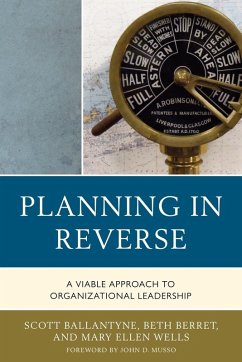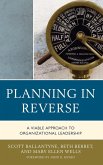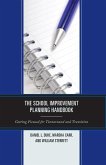Scott Ballantyne, Beth Berret, Mary Ellen Wells
Planning in Reverse
A Viable Approach to Organizational Leadership
Scott Ballantyne, Beth Berret, Mary Ellen Wells
Planning in Reverse
A Viable Approach to Organizational Leadership
- Broschiertes Buch
- Merkliste
- Auf die Merkliste
- Bewerten Bewerten
- Teilen
- Produkt teilen
- Produkterinnerung
- Produkterinnerung
This book provides a new process to greatly improve the performance of organizations. It is purposely designed to enhance the strategic planning processes of large organizations and may replace the process entirely for smaller organizations. Finally, a book that makes sense and can be put to use immediately.
Andere Kunden interessierten sich auch für
![Planning in Reverse Planning in Reverse]() Scott BallantynePlanning in Reverse66,99 €
Scott BallantynePlanning in Reverse66,99 €![School Improvement Planning Handbook School Improvement Planning Handbook]() Daniel L. DukeSchool Improvement Planning Handbook91,99 €
Daniel L. DukeSchool Improvement Planning Handbook91,99 €![School District Master Planning School District Master Planning]() Kelley D. CareySchool District Master Planning81,99 €
Kelley D. CareySchool District Master Planning81,99 €![School Improvement Planning Handbook School Improvement Planning Handbook]() Daniel L. DukeSchool Improvement Planning Handbook51,99 €
Daniel L. DukeSchool Improvement Planning Handbook51,99 €![Strategic Planning in Public Secondary Schools in Tanzania Strategic Planning in Public Secondary Schools in Tanzania]() Malimi JoramStrategic Planning in Public Secondary Schools in Tanzania36,99 €
Malimi JoramStrategic Planning in Public Secondary Schools in Tanzania36,99 €![Surveying the practice of strategic planning for school excellence Surveying the practice of strategic planning for school excellence]() Lasisi Abass AyodeleSurveying the practice of strategic planning for school excellence32,99 €
Lasisi Abass AyodeleSurveying the practice of strategic planning for school excellence32,99 €![Individual Education Planning (IEP): Equipping Teachers in Addressing Learners' Diversity Individual Education Planning (IEP): Equipping Teachers in Addressing Learners' Diversity]() Elymar PascualIndividual Education Planning (IEP): Equipping Teachers in Addressing Learners' Diversity26,99 €
Elymar PascualIndividual Education Planning (IEP): Equipping Teachers in Addressing Learners' Diversity26,99 €-
-
-
This book provides a new process to greatly improve the performance of organizations. It is purposely designed to enhance the strategic planning processes of large organizations and may replace the process entirely for smaller organizations. Finally, a book that makes sense and can be put to use immediately.
Produktdetails
- Produktdetails
- Verlag: R&L Education
- Seitenzahl: 142
- Erscheinungstermin: 16. Februar 2011
- Englisch
- Abmessung: 229mm x 152mm x 8mm
- Gewicht: 217g
- ISBN-13: 9781607097938
- ISBN-10: 1607097931
- Artikelnr.: 32924566
- Herstellerkennzeichnung
- Libri GmbH
- Europaallee 1
- 36244 Bad Hersfeld
- gpsr@libri.de
- Verlag: R&L Education
- Seitenzahl: 142
- Erscheinungstermin: 16. Februar 2011
- Englisch
- Abmessung: 229mm x 152mm x 8mm
- Gewicht: 217g
- ISBN-13: 9781607097938
- ISBN-10: 1607097931
- Artikelnr.: 32924566
- Herstellerkennzeichnung
- Libri GmbH
- Europaallee 1
- 36244 Bad Hersfeld
- gpsr@libri.de
Scott Ballantyne, PRSBA is an associate professor of business at Alvernia University, Reading, PA and earned his doctorate from Widener University, Chester, PA. He has held a variety of leadership positions in the public and private sector including school district business manager. Beth A. Berret, SPHR is an associate professor of business at Alvernia University with 21 years of teaching experience. She holds an MBA from Philadelphia University and doctorate from Widener University. Dr. Berret teaches in the tracks where she has professionally practiced including management, human resource management, and strategic management. Mary Ellen Wells is an associate professor and department chair for business programs at Alvernia University in Reading, Pennsylvania. She earned her law degree and advanced degree in taxation from Boston University School of Law. Prior to joining Alvernia University full time in 2003, Professor Wells was employed as a corporate and tax law attorney at the law firm of Bulkley, Richardson, and Gelinas in Springfield, Massachusetts.
Part 1 SECTION 1: SHORT TERM LEADERSHIP FOR LONG TERM VIABILITY
Chapter 2 Chapter 1: Short term leadership for long term viability
Chapter 3 Chapter 2: The pathway to long term viability
Chapter 4 Chapter 3: The new leadership skill set
Part 5 SECTION 2: DECONSTRUCTING DECISION MAKING
Chapter 6 Chapter 4: The current practice of long term planning
Chapter 7 Chapter 5: Deconstructing the process to demonstrate the fallacy
Chapter 8 Chapter 6: The future is never accurately predicted
Part 9 SECTION 3: PLANNING IN REVERSE
Chapter 10 Chapter 7: The I-process-
Chapter 11 Chapter 8: Implication scan-
Chapter 12 Chapter 9: Impact evaluation
Chapter 13 Chapter 10: Recommended action plans
Chapter 14 Chapter 11: Implementation plans
Chapter 15 Chapter 12: Integration plans
Part 16 SECTION 4: LEARNING IN REVERSE
Chapter 17 Chapter 13: How to retrain strategic leaders in the Planning in
Reverse process
Chapter 18 Chapter 14: Understanding the switch from long term planning to
long term viability
Chapter 19 Chapter 15: Short sighted leadership provides long term
viability
Part 20 SECTION 5: REVERSE PROCESS PLANNING
Chapter 21 Chapter 16: Develop a realistic timeline
Chapter 22 Chapter 17: The instrument utilized to identify areas of concern
Chapter 23 Chapter 18: The process needed to train new PIR leaders
Chapter 24 Chapter 19: The ongoing instrument to continue PIR
Chapter 25 Chapter 20: The intended results
Part 26 SECTION 6: APPENDICES
Chapter 27 Appendix A: Forms
Chapter 28 Appendix B: Full Example
Chapter 2 Chapter 1: Short term leadership for long term viability
Chapter 3 Chapter 2: The pathway to long term viability
Chapter 4 Chapter 3: The new leadership skill set
Part 5 SECTION 2: DECONSTRUCTING DECISION MAKING
Chapter 6 Chapter 4: The current practice of long term planning
Chapter 7 Chapter 5: Deconstructing the process to demonstrate the fallacy
Chapter 8 Chapter 6: The future is never accurately predicted
Part 9 SECTION 3: PLANNING IN REVERSE
Chapter 10 Chapter 7: The I-process-
Chapter 11 Chapter 8: Implication scan-
Chapter 12 Chapter 9: Impact evaluation
Chapter 13 Chapter 10: Recommended action plans
Chapter 14 Chapter 11: Implementation plans
Chapter 15 Chapter 12: Integration plans
Part 16 SECTION 4: LEARNING IN REVERSE
Chapter 17 Chapter 13: How to retrain strategic leaders in the Planning in
Reverse process
Chapter 18 Chapter 14: Understanding the switch from long term planning to
long term viability
Chapter 19 Chapter 15: Short sighted leadership provides long term
viability
Part 20 SECTION 5: REVERSE PROCESS PLANNING
Chapter 21 Chapter 16: Develop a realistic timeline
Chapter 22 Chapter 17: The instrument utilized to identify areas of concern
Chapter 23 Chapter 18: The process needed to train new PIR leaders
Chapter 24 Chapter 19: The ongoing instrument to continue PIR
Chapter 25 Chapter 20: The intended results
Part 26 SECTION 6: APPENDICES
Chapter 27 Appendix A: Forms
Chapter 28 Appendix B: Full Example
Part 1 SECTION 1: SHORT TERM LEADERSHIP FOR LONG TERM VIABILITY
Chapter 2 Chapter 1: Short term leadership for long term viability
Chapter 3 Chapter 2: The pathway to long term viability
Chapter 4 Chapter 3: The new leadership skill set
Part 5 SECTION 2: DECONSTRUCTING DECISION MAKING
Chapter 6 Chapter 4: The current practice of long term planning
Chapter 7 Chapter 5: Deconstructing the process to demonstrate the fallacy
Chapter 8 Chapter 6: The future is never accurately predicted
Part 9 SECTION 3: PLANNING IN REVERSE
Chapter 10 Chapter 7: The I-process-
Chapter 11 Chapter 8: Implication scan-
Chapter 12 Chapter 9: Impact evaluation
Chapter 13 Chapter 10: Recommended action plans
Chapter 14 Chapter 11: Implementation plans
Chapter 15 Chapter 12: Integration plans
Part 16 SECTION 4: LEARNING IN REVERSE
Chapter 17 Chapter 13: How to retrain strategic leaders in the Planning in
Reverse process
Chapter 18 Chapter 14: Understanding the switch from long term planning to
long term viability
Chapter 19 Chapter 15: Short sighted leadership provides long term
viability
Part 20 SECTION 5: REVERSE PROCESS PLANNING
Chapter 21 Chapter 16: Develop a realistic timeline
Chapter 22 Chapter 17: The instrument utilized to identify areas of concern
Chapter 23 Chapter 18: The process needed to train new PIR leaders
Chapter 24 Chapter 19: The ongoing instrument to continue PIR
Chapter 25 Chapter 20: The intended results
Part 26 SECTION 6: APPENDICES
Chapter 27 Appendix A: Forms
Chapter 28 Appendix B: Full Example
Chapter 2 Chapter 1: Short term leadership for long term viability
Chapter 3 Chapter 2: The pathway to long term viability
Chapter 4 Chapter 3: The new leadership skill set
Part 5 SECTION 2: DECONSTRUCTING DECISION MAKING
Chapter 6 Chapter 4: The current practice of long term planning
Chapter 7 Chapter 5: Deconstructing the process to demonstrate the fallacy
Chapter 8 Chapter 6: The future is never accurately predicted
Part 9 SECTION 3: PLANNING IN REVERSE
Chapter 10 Chapter 7: The I-process-
Chapter 11 Chapter 8: Implication scan-
Chapter 12 Chapter 9: Impact evaluation
Chapter 13 Chapter 10: Recommended action plans
Chapter 14 Chapter 11: Implementation plans
Chapter 15 Chapter 12: Integration plans
Part 16 SECTION 4: LEARNING IN REVERSE
Chapter 17 Chapter 13: How to retrain strategic leaders in the Planning in
Reverse process
Chapter 18 Chapter 14: Understanding the switch from long term planning to
long term viability
Chapter 19 Chapter 15: Short sighted leadership provides long term
viability
Part 20 SECTION 5: REVERSE PROCESS PLANNING
Chapter 21 Chapter 16: Develop a realistic timeline
Chapter 22 Chapter 17: The instrument utilized to identify areas of concern
Chapter 23 Chapter 18: The process needed to train new PIR leaders
Chapter 24 Chapter 19: The ongoing instrument to continue PIR
Chapter 25 Chapter 20: The intended results
Part 26 SECTION 6: APPENDICES
Chapter 27 Appendix A: Forms
Chapter 28 Appendix B: Full Example








